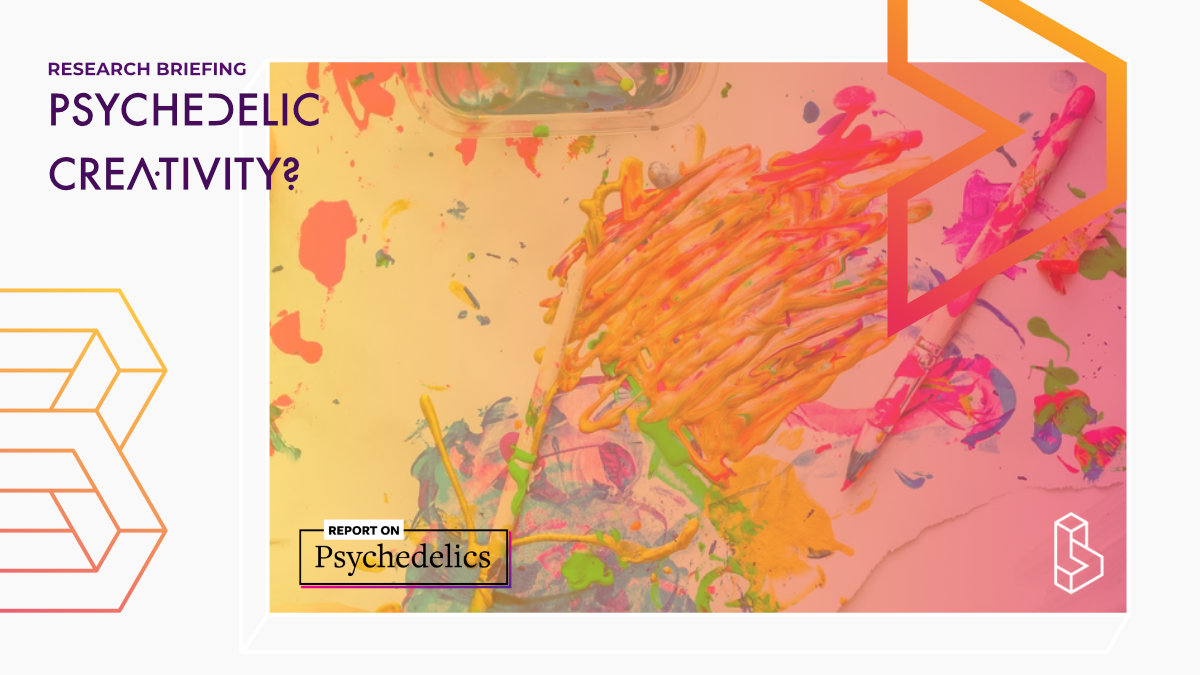This research briefing is co-published with the excellent Report on Psychedelics.
April 14th 2021
In The Research Briefing:
- Creativity is impaired whilst under the influence of psilocybin
- Ethical and legal considerations for clinicians with patients who use psychedelics
- Psychedelics make it to the ‘New England Journal of Medicine’
CREATIVITY
Fewer creative thoughts under the influence of psilocybin
It’s been a story told many times over, the use of psychedelics that sparked a creative insight. Steve Jobs described taking LSD as one of his most important and profound experiences of his life. Here he is in full:
“LSD shows you that there’s another side to the coin, and you can’t remember it when it wears off, but you know it. It reinforced my sense of what was important—creating great things instead of making money, putting things back into the stream of history and of human consciousness as much as I could.”
A double-blind placebo-controlled study by Natasha Mason and colleagues throws a big wrench into the creative narrative that accompany psychedelics. During the study, and seven days later, they administrated several tests to measure two components of creativity. These are known as divergent (e.g. coming up with many novel ideas) and convergent (e.g. finding the one right solution, bringing ideas together) thinking.
What the study found
- The 30 participants felt more insightful whilst under the influence of a high dose of psilocybin
- But they generated fewer ideas and did less well in evaluating the right solution than the 30 participants in the placebo group
- Seven days later, the psilocybin group still scored lower on one measure of convergent thinking, but higher on the novelty of their ideas on the other test
So does this mean that creativity is really impaired under the influence of psychedelics? Yes, at least in this study and when measuring it with these tests. Measuring spontaneous creative processes, may still turn out to show benefits of psychedelics on creativity. A study that employs ayahuasca that investigates this is currently ongoing.
SAFETY
How therapists can reduce harm and maximize benefits
As a direct result of the increased visibility of psychedelics as therapeutics, thanks in part to the clinical studies of the last 20 years, more people are using psychedelics as therapeutics. A policy paper tackles the ethical and legal issues that are become ever more relevant for therapists who have clients that use psychedelics. This is discussed this with the context of US regulations but lessons can generalize to other countries.
Therapists currently have no legal options, besides ketamine, to prescribe psychedelics and to help guide an experience. But they do have ways of supporting clients by providing information before (preparation) and after (integration) an experience. How to best do this is discussed here within a harm reduction context. This means that therapists don’t try and discourage use (as has traditionally been done), but focus on how to reduce risks.
Some of the excellent suggestions
- Therapists should encourage drug testing, but refrain from providing sourcing information
- They should know what is within their expertise, try to stay up to date with the literature, and refer to a specialists when needed (e.g. when a client wants to stop medications)
- The risk of legal action is present and can be reduced by being clear from the start that a therapists is in no way connected to the acute psychedelic experience
These are just some of the suggestions made in the paper. As psychedelics become more widely accepted, therapists should have all the tools available to help their patients thrive. Before legalization, this is one of the ways they can do this.
HISTORY
Psychedelics ascend to a top medical journal
This evening, Robin Carhart-Harris and his team will publish the results of a trial with psilocybin-assisted therapy for depression. Besides the study itself, which Carhart-Harris has been tweeting about vigorously, the journal it’s featured in highlights how far psychedelic research has come. The New England Journal of Medicine (NEJM) is among the most prestigious peer-reviewed medical journals as well as the oldest continuously published one.
The study itself, which we will reflect on next week, has been done with 59 participants (which is larger than most recent studies with psilocybin). Half of the participants received two very high dosages of psilocybin (25mg), separated by three weeks. What results were found, will be known soon.
We do know that the last publication about psychedelics in the NEJM was in 1960. This is what that study entailed:
- Four participants were given between 5 to 10mg of psilocybin
- The participants didn’t experience hallucinations, but thinking was slowed down
- And interestingly, only the pupils of one participant enlarged
At that time, these were the very first studies of (pure) psilocybin in humans. Now 41 years later, these molecules are on the verge of becoming medicines.
Research Report Readout
Psychedelic science is an interdisciplinary effort. A commentary by David Olson provides us with an overview of some of the latest studies being done with psychedelics.
The cognitive effects of ketamine administration. A study found acute declines in attention, executive function, and verbal memory. Only the effect on attention was larger in the patient groups who suffered from PTSD or depression. The baseline cognitive function of participants didn’t predict clinical outcomes.
What we know about the risks of psychedelics and bipolar depression. A pre-print finds that in the current literature there are some known, but limited, risks of activating mania with psilocybin for those with bipolar depression (BD). The review describes 15 cases of BD and the use of a range of psychedelics.
Become a psychedelic insider
Get a Pro Membership to enjoy these benefits & support Blossom📈 full reports on Topics & Compounds
🧵 full summary reviews of research papers
🚀 full access to new articles
See Memberships

